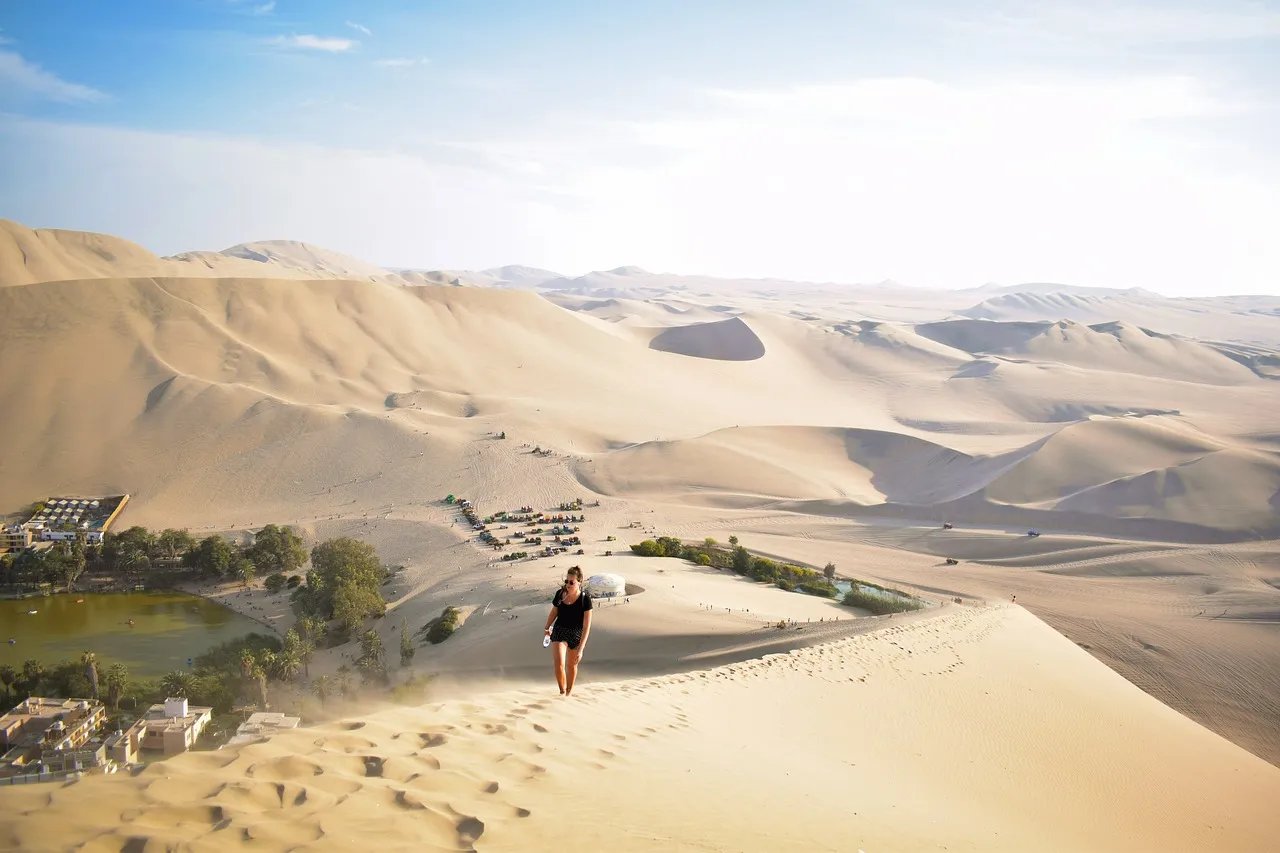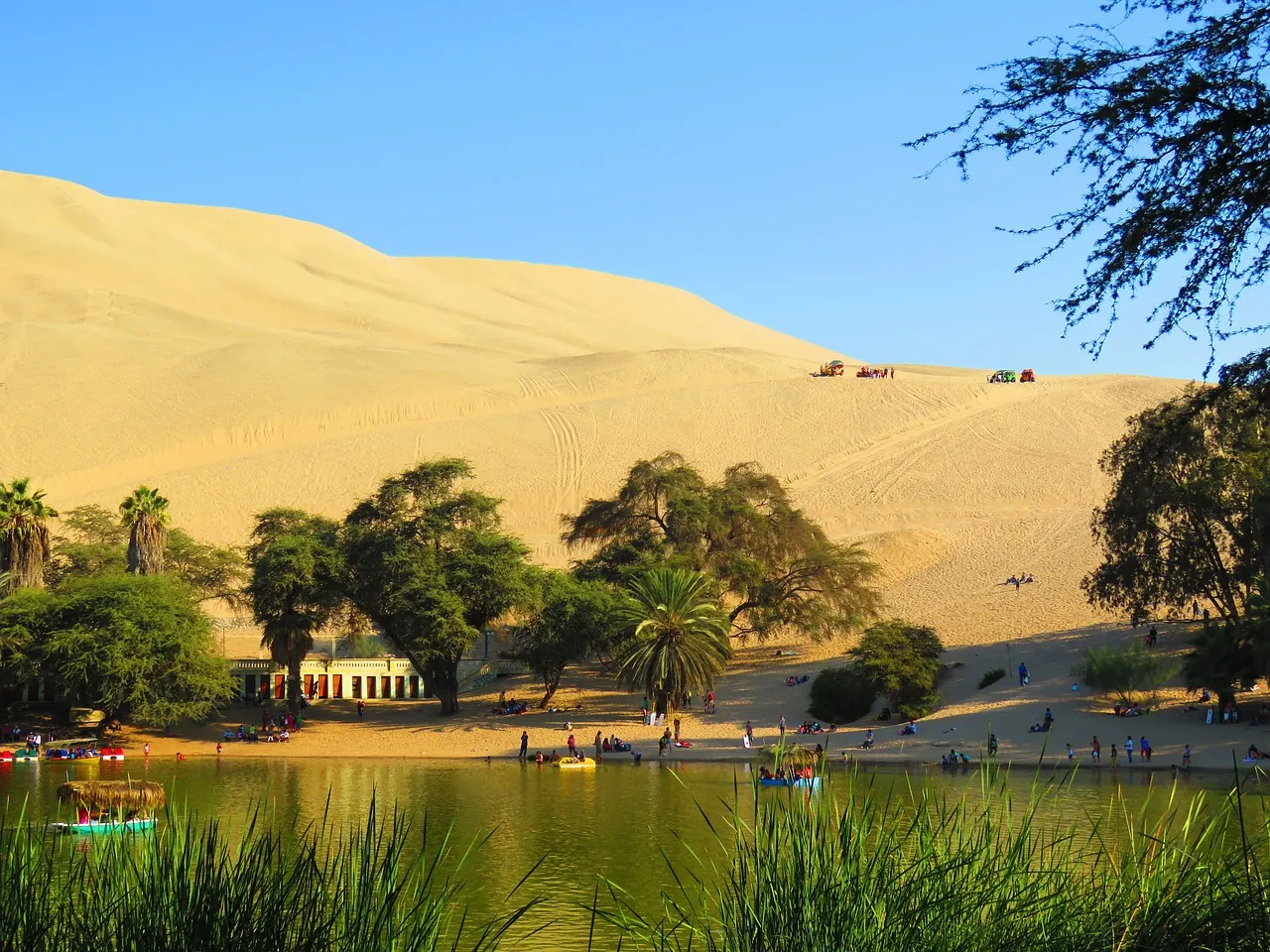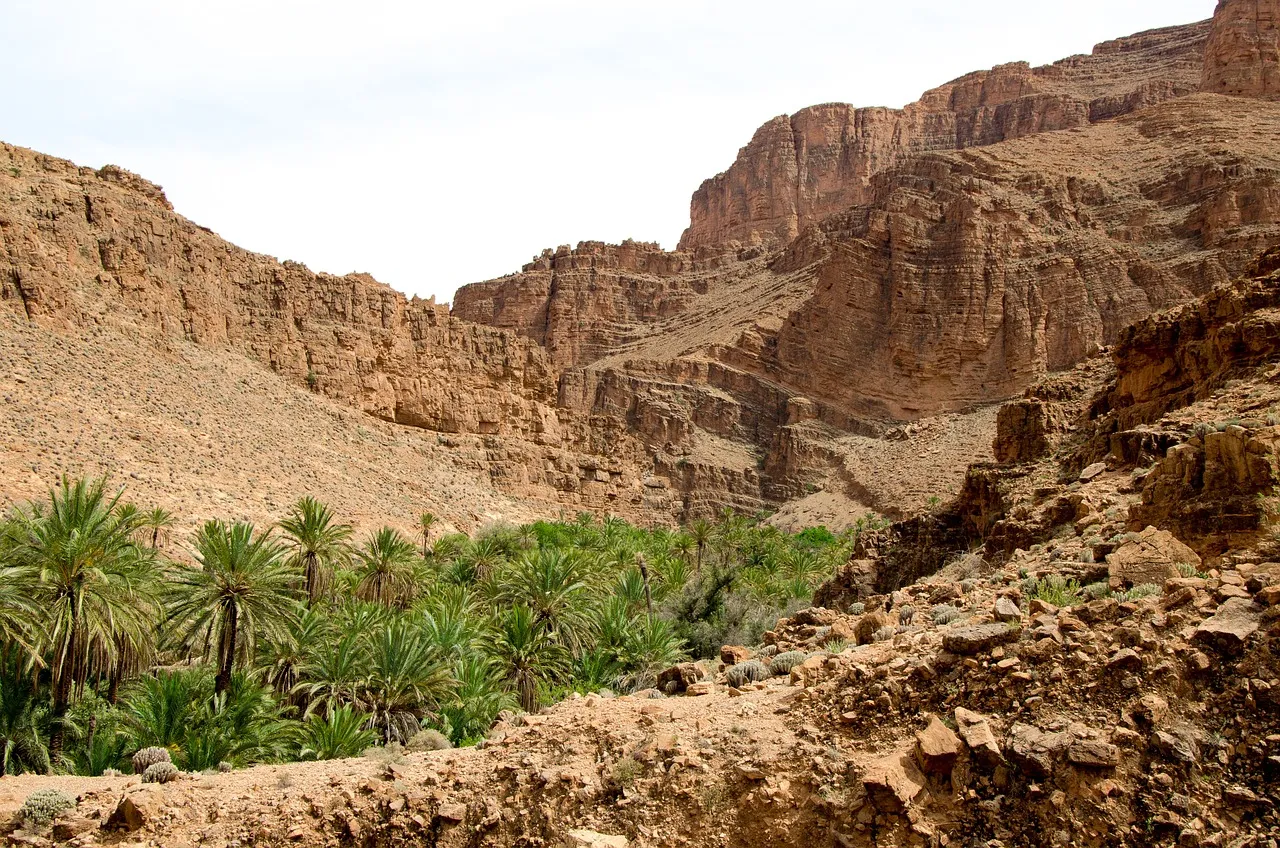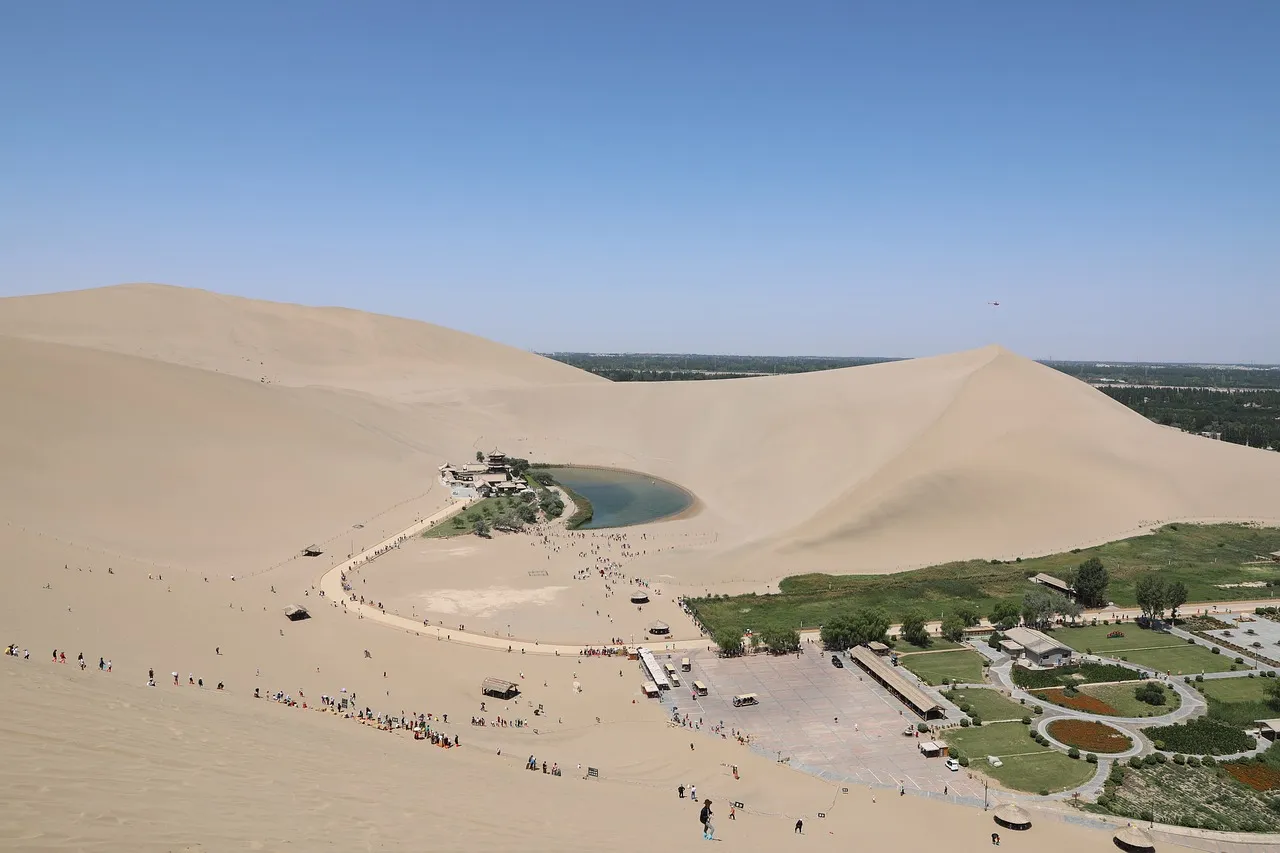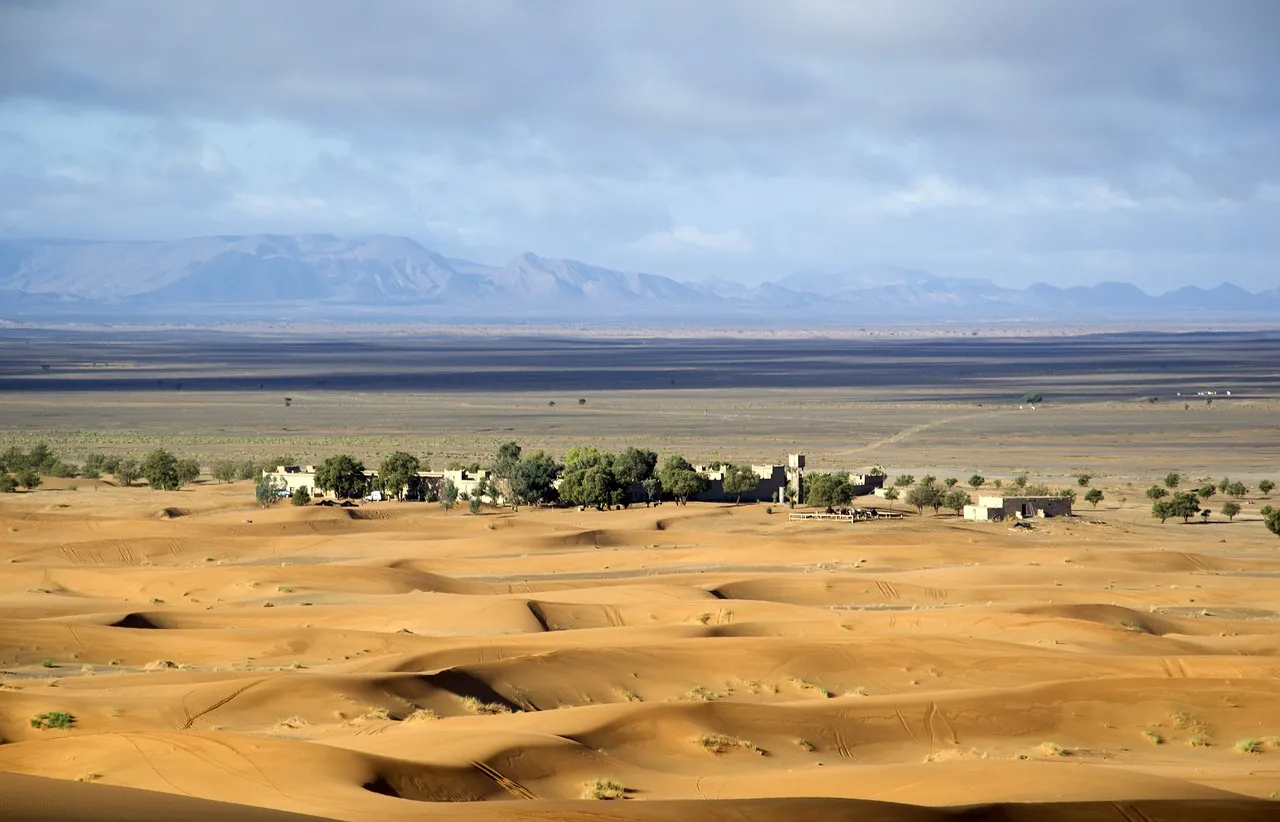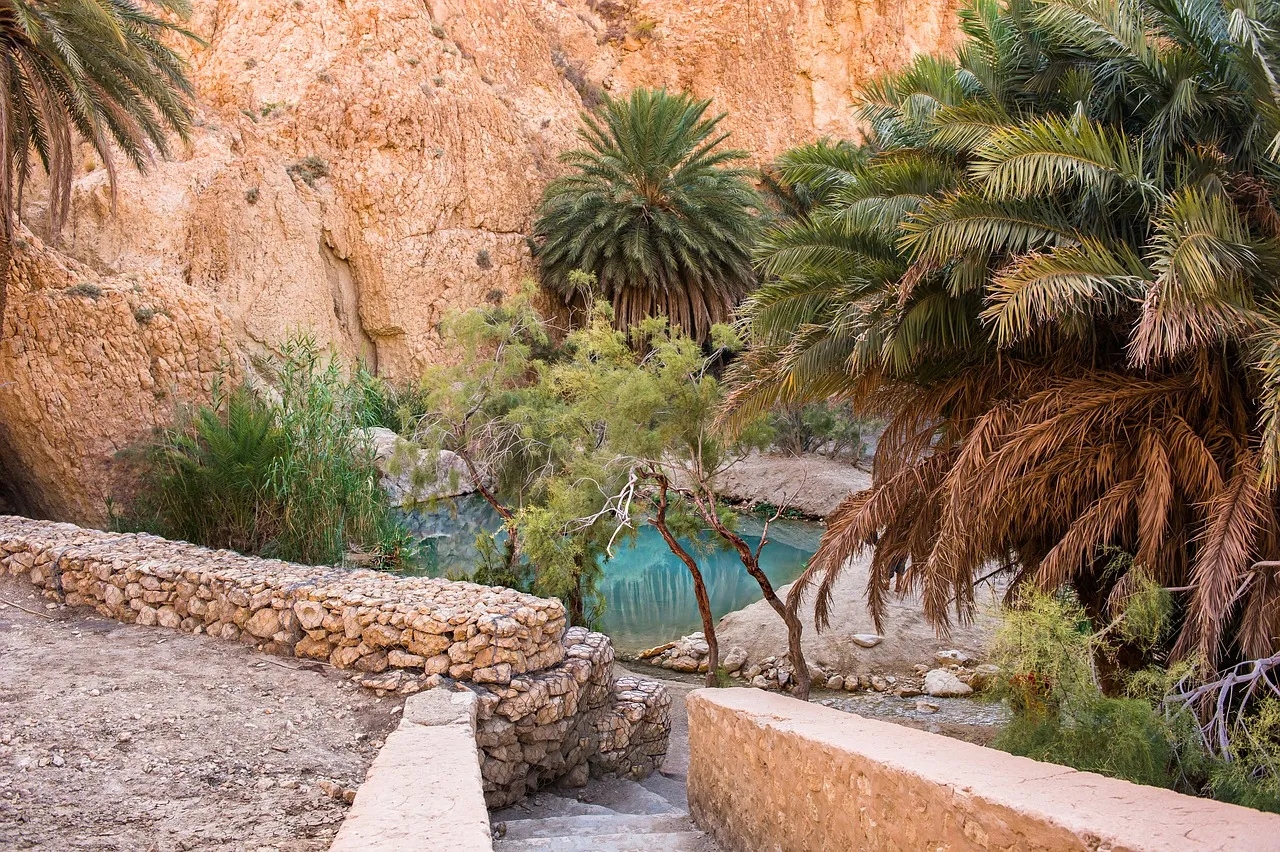Nestled amidst arid landscapes, the Middle Eastern oases stand as shimmering havens of life and respite. These verdant gems, surrounded by vast deserts, have been pivotal throughout history, serving as sources of sustenance, trade, and cultural exchange. In this blog post, we embark on an exploration of Middle Eastern oases, uncovering the captivating tales, unique ecosystems, and the timeless allure that defines these oases.
Middle Eastern Oasis Exploration
1. Historical Significance
Middle Eastern oases have played an integral role in the region’s history, acting as vital stops along ancient trade routes. Caravans traversing the deserts relied on these oases for water, food, and rest. Cities such as Palmyra and Petra owe their existence and prosperity to the presence of oases, serving as flourishing centers of commerce and culture.
2. Unique Ecosystems
The juxtaposition of lush greenery against the backdrop of arid deserts creates unique ecosystems within Middle Eastern oases. Date palms, fruit orchards, and other vegetation thrive in the fertile soil sustained by underground aquifers. These oases often host a variety of bird species, creating a harmonious blend of flora and fauna that defies the surrounding harsh environment.
3. Sustainable Agriculture
The ingenious cultivation techniques employed in Middle Eastern oases exemplify sustainable agriculture practices adapted to water scarcity. Traditional methods such as falaj irrigation systems, which distribute water from underground channels, ensure efficient and equitable water usage, allowing communities to grow crops in an environmentally conscious manner.
4. Architectural Marvels
Oases are not merely natural wonders; they also provide the backdrop for architectural marvels. Ancient settlements around oases showcase distinctive mud-brick architecture, with intricate designs that reflect the cultural and historical significance of these communities. Al-Ain in the United Arab Emirates, for instance, is known for its traditional falaj irrigation systems and well-preserved forts.
5. Cultural Oasis Festivals
Throughout the Middle East, oasis communities celebrate the importance of these life-sustaining oases through cultural festivals. These events often feature traditional music, dance, and culinary delights, providing visitors with a glimpse into the rich heritage and hospitality of the oasis communities.
6. Date Palms and Date Festivals
The date palm holds a special place in the heart of Middle Eastern oases. Date festivals celebrate the harvest of this iconic fruit, showcasing its various varieties and uses. The date palm not only provides sustenance but also serves as a symbol of resilience in the face of challenging climatic conditions.
7. Modern Oasis Retreats
While ancient oases continue to thrive, modern oasis retreats offer a luxurious escape into tranquility. Resorts and eco-friendly accommodations have emerged around some oases, providing visitors with the opportunity to experience the serenity and natural beauty of these paradisiacal landscapes.
8. Environmental Challenges
Despite their resilience, Middle Eastern oases face environmental challenges, including over-extraction of groundwater and climate change. Sustainable practices and conservation efforts are crucial to preserving these delicate ecosystems and ensuring their continued contribution to the region’s biodiversity.
9. Exploring Wadi Bani Khalid
Wadi Bani Khalid in Oman stands out as a prime example of a mesmerizing Middle Eastern oasis. Surrounded by rugged mountains, this oasis is characterized by turquoise pools, palm groves, and lush vegetation. Visitors can explore the enchanting wadi, swim in clear pools, and marvel at the natural beauty that defines this hidden oasis.
10. Future Prospects and Conservation
As we delve into the allure of Middle Eastern oases, it becomes imperative to consider their future prospects and the importance of conservation efforts. Sustainable water management, community involvement, and responsible tourism practices are essential components of preserving these oases for future generations.
Middle Eastern oases, with their historical resonance, unique ecosystems, and cultural significance, beckon explorers and enthusiasts alike. Beyond their role as geographical features, these oases symbolize the indomitable spirit of life thriving in even the harshest environments. As we venture into the heart of these tranquil havens, let us appreciate their contribution to history, ecology, and the cultural tapestry of the Middle East, ensuring their preservation for generations to come.
Oasis locations in the Middle East
The Middle East, known for its vast deserts and ancient civilizations, conceals hidden treasures amid the arid landscapes – oasis locations that offer a stark contrast to the surrounding desolation. In this blog post, we embark on an exploration of these enchanting oases, unveiling their unique features, historical significance, and the allure they hold for travelers seeking respite in the heart of the desert.
1. Bahariya Oasis, Egypt
Nestled in the Western Desert of Egypt, the Bahariya Oasis is a verdant jewel surrounded by golden sand dunes. Famous for its lush date palm groves and hot springs, this oasis has a rich historical heritage, with ancient tombs and temples scattered across its landscape. Travelers can explore the Valley of the Golden Mummies and enjoy the therapeutic properties of the hot springs.
2. Wadi Rum Oasis, Jordan
Known as the Valley of the Moon, Wadi Rum in Jordan is a surreal desert landscape dotted with unique rock formations and ancient petroglyphs. While not a traditional oasis with flowing water, Wadi Rum offers a captivating desert experience with its towering sandstone mountains and vast red sand expanses. Visitors can embark on jeep safaris, camel treks, or even spend a night under the stars in traditional Bedouin-style camps.
3. Al-Ain Oasis, United Arab Emirates
Nestled in the heart of the city of Al-Ain in the UAE, this oasis is a UNESCO World Heritage Site. Al-Ain Oasis is renowned for its traditional falaj irrigation system, which has sustained agriculture in the region for centuries. Visitors can stroll through the shaded pathways amidst date palm groves, visit the Al Ain National Museum, and witness the ancient agricultural practices that still thrive in this urban oasis.
4. Ein Gedi Oasis, Israel
Perched along the shores of the Dead Sea, Ein Gedi Oasis is an ecological gem in the Judean Desert. Fed by freshwater springs, this oasis supports a diverse range of flora and fauna, creating an oasis in the truest sense. Nature enthusiasts can explore hiking trails that lead to waterfalls, natural pools, and the opportunity to encounter wildlife such as ibex and hyraxes.
5. Siwa Oasis, Egypt
Tucked away near the Egyptian-Libyan border, Siwa Oasis is a lush haven surrounded by towering sand dunes. Renowned for its ancient Oracle Temple of Amun, Siwa offers a unique cultural experience. The oasis is famous for its olive orchards, freshwater springs, and the iconic salt lakes. Travelers can immerse themselves in the local Berber culture, indulge in traditional Siwan cuisine, and explore the historic sites that dot the landscape.
6. Al-Hasa Oasis, Saudi Arabia
Located in the eastern part of Saudi Arabia, Al-Hasa Oasis is one of the largest oasis complexes in the world. With an extensive network of canals (falaj), the oasis sustains agriculture in the region, showcasing the ingenious methods employed by ancient inhabitants to harness water in the desert. Date palm groves, historic mud-brick forts, and traditional souks characterize this culturally rich oasis.
7. Al-Sarar Oasis, Saudi Arabia
In the vast Rub’ al Khali, also known as the Empty Quarter, lies the hidden gem of Al-Sarar Oasis. Remote and largely unexplored, this oasis offers a glimpse into the raw beauty of the desert. The contrast between the golden sands and the greenery of the oasis is a sight to behold. Travelers seeking solitude and a genuine desert experience can venture into the depths of Al-Sarar.
8. Jericho Oasis, Palestine
Known as the “City of Palms,” Jericho boasts one of the oldest continuously inhabited settlements in the world. The oasis in Jericho is sustained by the abundant spring of Ein Sultan, providing a lush environment in the midst of the arid Jordan Valley. Visitors can explore historical sites like the ancient city walls and the Mount of Temptation while enjoying the tranquility of the oasis.
Middle Eastern oases, with their ancient charm and ecological significance, offer a unique perspective on the resilience of life in the desert. Each oasis, steeped in history and surrounded by stunning landscapes, invites travelers to uncover the secrets hidden within their fertile grounds. Whether exploring the palm groves of Al-Ain or the remote beauty of Al-Sarar, these oasis locations beckon adventurers to embark on a journey through time and nature in the heart of the Middle East.
Desert oasis travel guide
Embarking on a journey to explore desert oases is a captivating endeavor that unveils the hidden beauty and tranquility nestled within arid landscapes. In this comprehensive travel guide, we will navigate the enchanting world of desert oases, offering insights into planning an unforgettable oasis adventure.
1. Choosing Your Oasis Destination
The world is adorned with diverse desert oases, each offering a unique experience. Research and choose your destination based on preferences—whether it’s the historical allure of Egypt’s Bahariya Oasis, the cultural richness of Morocco’s Draa Valley, or the remote beauty of the Al-Sarar Oasis in Saudi Arabia. Consider factors such as climate, accessibility, and the activities each oasis destination offers.
2. Best Time to Visit
Desert climates vary, and choosing the right time to visit is crucial for an optimal experience. While oases maintain their allure year-round, consider visiting during the milder seasons to avoid extreme temperatures. Spring and fall are often ideal, offering pleasant weather for exploration without the scorching heat of summer.
3. Understanding Local Cultures
Desert oases are often surrounded by communities with rich cultural traditions. Before embarking on your journey, take the time to understand the local customs and traditions. Respectful interaction with the local population enhances your travel experience and fosters positive relationships.
4. Packing Essentials
Packing smart is key when venturing into the desert. Essentials include lightweight and breathable clothing to combat the heat, a wide-brimmed hat for sun protection, sturdy hiking boots for exploration, and ample water to stay hydrated. Additionally, pack sunscreen, a camera to capture the stunning landscapes, and a scarf or shawl for protection against wind and dust.
5. Transportation and Accessibility
Consider the accessibility of your chosen oasis. Some oases may require specific modes of transportation, such as 4×4 vehicles or guided tours. Research transportation options and plan accordingly. Ensure that your chosen oasis is reachable by your preferred mode of travel, whether it’s by car, bus, or guided tours.
6. Accommodations in Oasis Settings
While some desert oases offer luxurious resorts, others provide more rustic accommodations that immerse you in the natural surroundings. Choose accommodations that align with your preferences and budget. Desert camps, eco-friendly lodges, and traditional guesthouses can enhance the overall oasis experience.
7. Exploring Oasis Activities
Desert oases offer a myriad of activities for travelers seeking both relaxation and adventure. Explore hiking trails that lead to hidden waterfalls, embark on camel treks through the dunes, or take a leisurely stroll through lush palm groves. Many oases also provide opportunities for cultural experiences, including visits to historic sites, traditional markets, and encounters with local artisans.
8. Water Adventures
While deserts may seem devoid of water, many oases offer opportunities for unique water experiences. Enjoy refreshing dips in natural pools or hot springs, creating a harmonious blend of desert exploration and aquatic relaxation. Be sure to check if swimming or water activities are permitted in the specific oasis you plan to visit.
9. Wildlife Encounters
Desert oases are often havens for diverse flora and fauna. Keep an eye out for unique bird species, desert plants, and, in some cases, wildlife like gazelles or camels. Respect the natural habitat and capture the beauty of these encounters with your camera.
10. Responsible Travel Practices
As you embark on your oasis adventure, prioritize responsible travel practices. Minimize your environmental impact by adhering to designated trails, respecting local flora and fauna, and following the principles of “Leave No Trace.” Contribute positively to the local economy by supporting local businesses and engaging in sustainable tourism practices.
A journey to explore desert oases is a captivating tapestry of history, culture, and natural wonders. This comprehensive travel guide aims to equip you with the essential insights to plan a memorable oasis adventure. Whether you seek the lush landscapes of Morocco’s Draa Valley or the timeless allure of Egypt’s Bahariya Oasis, the enchanting world of desert oases awaits your exploration. Embrace the tranquility, immerse yourself in local cultures, and savor the unique experiences that these hidden gems have to offer.
Oasis culture and history
Desert oases stand as timeless witnesses to the ebb and flow of civilizations, each oasis harboring a unique cultural heritage that echoes through the ages. In this exploration of oasis culture and history, we delve into the enchanting narratives woven into the fabric of these verdant sanctuaries amidst arid landscapes.
1. The Ancient Heartbeat of Oases
Oases have been pivotal throughout human history, serving as waypoints for ancient trade routes and centers of cultural exchange. The oasis culture, deeply rooted in sustainability and adaptation, reflects the ingenious ways in which communities have thrived in harsh desert environments. From the falaj irrigation systems in Oman to the qanat systems in Iran, these ancient water management techniques are testimonies to the resilience of oasis cultures.
2. Architectural Marvels
Oases are often adorned with architectural marvels that tell tales of a bygone era. Mud-brick forts, traditional houses, and intricate irrigation channels are common features in many oasis communities. The architecture is not merely functional but also reflects the cultural identity of the inhabitants. Al-Ain Oasis in the United Arab Emirates, with its historic mud-brick structures and falaj systems, is a living testament to this architectural heritage.
3. Cultural Festivals and Traditions
Oasis communities celebrate their cultural heritage through vibrant festivals and traditions. These events often showcase traditional music, dance, and culinary delights, providing visitors with a glimpse into the local way of life. Siwa Oasis in Egypt, famous for its annual Date Festival, is a prime example of how oases celebrate their agricultural heritage and the role of the date palm in their culture.
4. Indigenous Wisdom and Practices
Indigenous communities residing in and around oases have preserved ancient wisdom and practices passed down through generations. These practices encompass sustainable agriculture, water management, and desert survival skills. The Bedouin communities, often associated with desert regions and oases, exemplify a nomadic lifestyle deeply connected to the rhythms of the desert and its oases.
5. Trade and Cultural Exchange
Oases have historically been hubs for trade and cultural exchange. The convergence of trade routes in oasis settlements facilitated the exchange of goods, ideas, and artistic influences. The Silk Road, for instance, connected oasis cities like Kashgar in China with the cultural melting pot of Samarkand in Uzbekistan, fostering a crossroads of cultures that enriched the oasis heritage.
6. Literary and Artistic Inspirations
Oases have inspired poets, writers, and artists throughout history. The lushness amid the desert expanse, the play of light on palm groves, and the tranquil ambiance have been recurrent themes in literature and art. The poetry of ancient Arabian poets, the writings of explorers like Ibn Battuta, and the paintings of Orientalist artists capture the allure of oasis culture.
7. Spiritual Significance
Many oases hold spiritual significance, with ancient temples, shrines, and sacred sites dotting the landscape. The oasis of Jericho in Palestine, considered one of the oldest continuously inhabited settlements, is associated with biblical narratives and is believed to be the place where Jesus was baptized. The spiritual resonance of oases adds a layer of mystique to their cultural history.
8. Traditional Craftsmanship
Oasis communities often boast traditional craftsmanship that reflects their cultural identity. From intricate pottery in Morocco’s Draa Valley to the weaving traditions in Oman’s oasis communities, these crafts are not only functional but also carry a deep cultural significance. Visitors can explore local markets to witness and acquire these handmade treasures.
9. Modern Challenges and Preservation Efforts
While oasis culture and history are rich and resilient, they face modern challenges such as water scarcity, urbanization, and environmental changes. Conservation efforts are essential to preserve the unique heritage of oases. Organizations, communities, and governments are working together to implement sustainable practices and ensure the continued vitality of oasis culture.
10. Sustainable Tourism and Cultural Immersion
Engaging in sustainable tourism practices allows visitors to immerse themselves in oasis culture while contributing positively to the local economy. Staying in eco-friendly accommodations, supporting local artisans, and participating in cultural experiences foster a deeper connection with the oasis heritage.
Oasis culture and history embody the endurance of communities in the face of challenging environments. From ancient trade routes to vibrant festivals, from architectural marvels to indigenous wisdom, each oasis tells a story of adaptation and resilience. As we explore these verdant havens amidst the desert expanse, let us cherish and preserve the cultural tapestry woven into the very fabric of oasis life, ensuring that these timeless narratives endure for generations to come.
How to visit Middle Eastern oases
Embarking on a journey to explore Middle Eastern oases is a unique and enriching experience that promises a tapestry of history, culture, and natural beauty. In this comprehensive guide, we will navigate the intricacies of planning a visit to Middle Eastern oases, providing insights into the best practices for a memorable and immersive adventure.
1. Research and Choose Your Oasis Destination
The Middle East boasts a diverse array of oases, each with its own charm and cultural significance. Begin your journey by researching and choosing the oasis destination that aligns with your interests and preferences. Whether it’s the historic allure of Egypt’s Siwa Oasis or the architectural marvels of Al-Ain Oasis in the UAE, understanding the unique features of each oasis will enhance your overall experience.
2. Best Time to Visit
Understanding the climate of the Middle East is crucial when planning a visit to oases. While oases maintain their allure throughout the year, consider visiting during milder seasons to avoid extreme temperatures. Spring and fall are generally considered ideal, offering pleasant weather for exploration without the scorching heat of summer.
3. Transportation Options
The accessibility of Middle Eastern oases varies, and choosing the right mode of transportation is essential. Some oases may require 4×4 vehicles for off-road exploration, while others are easily accessible by car or public transportation. Research the transportation options available for your chosen oasis and plan accordingly.
4. Accommodations in Oasis Settings
Selecting the right accommodations enhances the overall oasis experience. From luxurious resorts to eco-friendly lodges and traditional guesthouses, Middle Eastern oases offer a range of stay options. Consider the type of experience you seek – whether it’s a luxury retreat or a more rustic, immersive stay – and choose accommodations that align with your preferences and budget.
5. Cultural Sensitivity
Middle Eastern oases are often surrounded by communities with rich cultural traditions. It is essential to approach these communities with respect and cultural sensitivity. Familiarize yourself with local customs and traditions, dress modestly, and seek permission before photographing locals. Embracing the local culture adds depth to your oasis experience and fosters positive interactions.
6. Guided Tours and Local Guides
Consider opting for guided tours or hiring local guides to enhance your exploration of Middle Eastern oases. Experienced guides can provide valuable insights into the history, culture, and ecology of the oasis, ensuring a more enriching experience. Whether it’s a walking tour through historic sites or a jeep safari into the dunes, guided experiences offer a deeper understanding of the oasis landscape.
7. Understanding Entry Requirements
Before traveling to a Middle Eastern oasis, check and understand the entry requirements. Some oases may be located in protected areas, requiring permits for entry. Ensure that you have the necessary permissions and adhere to any regulations set by local authorities to preserve the delicate ecosystem of the oasis.
8. Packing Essentials
Packing smart is essential for a comfortable and enjoyable visit to Middle Eastern oases. Essentials include lightweight and breathable clothing suitable for the desert climate, a wide-brimmed hat for sun protection, sturdy hiking boots, and a refillable water bottle to stay hydrated. Don’t forget to pack sunscreen, a camera for capturing the stunning landscapes, and a scarf or shawl for protection against wind and dust.
9. Exploring Oasis Activities
Middle Eastern oases offer a plethora of activities for travelers. Explore hiking trails that lead to hidden waterfalls, embark on camel treks through the dunes, or take a leisurely stroll through lush palm groves. Many oases also provide opportunities for cultural experiences, including visits to historic sites, traditional markets, and encounters with local artisans.
10. Responsible Tourism Practices
Responsible tourism is crucial for preserving the delicate ecosystems and cultural heritage of Middle Eastern oases. Adhere to designated trails, respect local flora and fauna, and follow the principles of “Leave No Trace.” Support local businesses and artisans, and engage in sustainable tourism practices to contribute positively to the preservation of these unique landscapes.
Visiting Middle Eastern oases is an immersive journey into the heart of history, culture, and natural wonders. This comprehensive guide provides valuable insights to help you plan and make the most of your oasis adventure. Whether you’re captivated by the ancient allure of Palmyra in Syria or drawn to the lush landscapes of Al-Ain in the UAE, embrace the tranquility, explore with an open heart, and savor the unique experiences that Middle Eastern oases have to offer.
Hidden oases in the Middle East
The Middle East, often associated with vast deserts and ancient cities, harbors hidden treasures that defy the arid landscapes – hidden oases that enchant with their lush greenery and serene beauty. In this exploration, we unveil the secrets of lesser-known oases in the Middle East, inviting travelers to discover these hidden gems off the beaten path.
1. As-Sabkha Oasis, Oman
Nestled in the heart of Oman’s vast desert, the As-Sabkha Oasis is a hidden marvel waiting to be discovered. Surrounded by towering sand dunes, this oasis boasts a unique ecosystem with vibrant birdlife and thriving vegetation. Visitors can explore the serene lake at the oasis, fed by natural springs, and enjoy the tranquility of this off-the-beaten-path destination.
2. Al-Qara Mountain Oasis, Saudi Arabia
Tucked away in the Al-Ahsa region of Saudi Arabia, the Al-Qara Mountain Oasis is a true hidden gem. Set against the backdrop of stunning rock formations, the oasis is a green haven fed by freshwater springs. The juxtaposition of the lush palm groves against the rugged mountains creates a picturesque landscape that transports visitors to a world of natural beauty and tranquility.
3. Umm Jirsan Oasis, UAE
In the heart of the United Arab Emirates, the Umm Jirsan Oasis offers a secluded retreat away from the bustling cities. This hidden oasis is surrounded by rolling sand dunes, providing a peaceful escape for those seeking solitude. The pristine desert landscape and the presence of freshwater pools make Umm Jirsan a captivating destination for those willing to venture off the well-trodden paths.
4. Ein Avdat Oasis, Israel
Nestled within the Negev Desert, Ein Avdat is an unexpected oasis that showcases the resilience of life in the arid landscape. Carved by the Zin River, this hidden gem features cascading waterfalls and lush vegetation against the backdrop of rugged cliffs. Visitors can hike through the gorge, marvel at the natural springs, and discover the surprising biodiversity that thrives in this hidden oasis.
5. Wadi Al-Hitan Oasis, Egypt
Often overshadowed by more famous Egyptian destinations, Wadi Al-Hitan, or the Valley of the Whales, is a hidden oasis with a unique twist. Located in the Western Desert, this oasis is not only surrounded by palm groves but also houses fossilized remains of ancient whales. The combination of natural beauty and paleontological significance makes Wadi Al-Hitan a hidden treasure waiting to be explored.
6. Al-Zulfi Springs, Saudi Arabia
In the heart of Saudi Arabia lies the Al-Zulfi Springs, an oasis that has managed to remain relatively undiscovered. Surrounded by date palm trees and fed by underground springs, this hidden gem offers a tranquil setting for relaxation. The natural pools formed by the springs provide a refreshing escape from the desert heat, making Al-Zulfi Springs a perfect off-the-beaten-path destination.
7. Qara Oasis, Jordan
Away from the well-trodden tourist routes in Jordan, Qara Oasis remains a hidden sanctuary. Located in the Dana Biosphere Reserve, this oasis is surrounded by dramatic canyons and offers a respite for nature enthusiasts. Visitors can embark on hiking trails that lead to Qara, discovering the surprising greenery nestled within the arid landscapes of southern Jordan.
8. Al-Sarar Oasis, Saudi Arabia
Deep within the Rub’ al Khali, or the Empty Quarter, lies the secluded Al-Sarar Oasis. This hidden gem is surrounded by towering sand dunes, creating a surreal contrast between the golden sands and the lush greenery. Al-Sarar offers an authentic desert experience for those seeking solitude and a genuine connection with the untouched beauty of the Arabian Peninsula.
9. Al-Muftil Oasis, Iraq
Amidst the vast desert expanse of Iraq, the Al-Muftil Oasis remains a hidden treasure awaiting discovery. Fed by natural springs, this oasis is a green paradise surrounded by the arid landscapes of southern Iraq. The date palm groves and traditional mud-brick structures add to the oasis’s charm, providing a glimpse into the authentic rural life of the region.
10. Al-Gara Cave Oasis, Oman
Combining the allure of an oasis with the mystique of caves, Al-Gara Cave Oasis in Oman is a hidden wonder worth exploring. The oasis is nestled within a cavernous landscape, where natural pools and lush greenery create an enchanting atmosphere. Exploring the caves and discovering the hidden corners of Al-Gara makes for a unique and memorable adventure off the traditional tourist trails.
The Middle East, with its rich tapestry of landscapes, conceals hidden oases that beckon intrepid travelers. Venturing beyond the well-known destinations allows for the discovery of these lesser-known gems, where the juxtaposition of greenery against the desert backdrop creates a captivating harmony. From the freshwater springs of Al-Qara Mountain Oasis to the fossilized wonders of Wadi Al-Hitan, each hidden oasis invites exploration and promises a truly unique experience for those willing to seek out the secrets of the Middle East.
